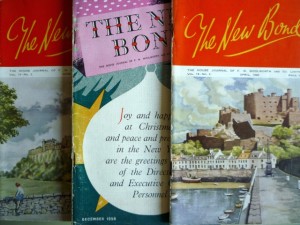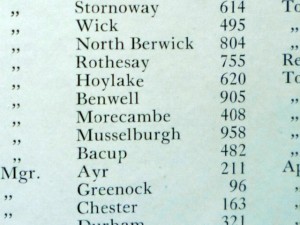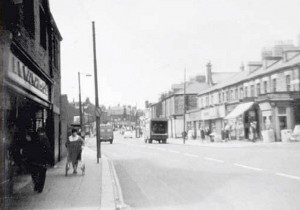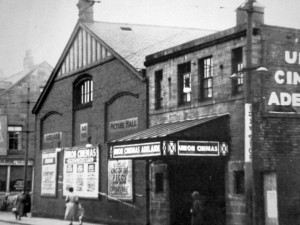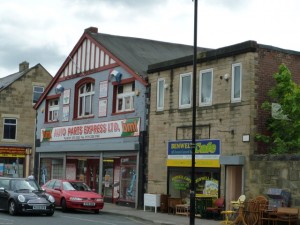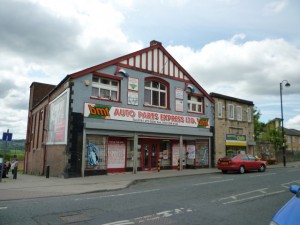
One of the things I most love about researching retail history is the way that interesting stories can emerge from the tiniest leads.
As a Woolworths enthusiast, I’ve recently discovered that a fantastic starting point for retail history nuggets of a Woolies nature is The New Bond, the ‘house journal’ of F. W. Woolworth & Co. Ltd that was published between 1935 and 1972. I’ve picked up a few editions from eBay – all from between 1956 and 1960 – and each one gives a fascinating snapshot of the business at the time.
Photographs of award presentations for long-serving staff sit alongside news of new stores, latest fashion patterns, recent staff weddings, articles and ‘appreciations’, all interspersed with colourful adverts for Dinkie curlers and Polythene Food Bags. The tone is all very quaint and paternalistic, of course, but some of today’s retailers could do worse than picking up some tips from how Woolies communicated and engaged with its staff half a century ago.
From a historical point of view, one of the most useful things about The New Bond is the way in which it immortalises Woolworths stores that had already closed many, many years before the whole business finally collapsed in 2008 – shops such as those in Ripley (now Amber Value) or Byker (now Decorflair), for instance, that shut down in the 80s or 90s. In many case, little detail of these stores being old Woolworths can be found on the web (or on site), meaning that written testimony (such as The New Bond), old photographs and postcards, and the memories of those old enough to remember become the main sources of evidence.
Here in the North East, I’m still using such sources to come across former Woolworths stores that I never knew existed, including ones in Blaydon (long demolished, and which I’m still planning to blog about), Sunderland’s Pennywell estate, and Crook in County Durham. I’m yet to do any research into the Crook store, but a quick look at Google Street View makes me think that it was more than likely in the premises currently occupied by Boots – a building that has all the usual architectural attributes of a purpose-built Woolies.
On that topic, I was intrigued to come across a reference in the June 1960 edition of The New Bond to a Woolworths store – number 905 – in the Newcastle suburb of Benwell. It crops up twice under the ‘Changes and Appointments’ column for ‘Liverpool District’, listing Mr W D Johnson, Manager, who had left Benwell to go and manage a new store (1034) in Stretford, and who was replaced by Mr T R Pearson, previously Deputy Manager of the Durham shop (321). Needless to say, I was completely unaware that Benwell had ever had a Woolworths, and was determined to find out more.
Fortunately, the obvious Google search for ‘Woolworths Benwell’ struck gold, bringing up a fascinating local heritage guide to Benwell’s Adelaide Terrace shops, including a photograph labelled “Looking west along the Terrace from Woolworths which was originally the Adelaide Cinema, c.1969”. As you might expect, I was now even more fascinated, given that there can’t be very many Woolworths that ever opened up in former cinemas.
Searching the web for anything to do with the Adelaide Cinema brought up very little of use, so I turned to my trusty Cinemas of Newcastle book by Frank Manders in the hope that it would enlighten me. Sure enough, the two-page spread about the ‘Adelaide Picture Hall’ added some detail to the story, revealing that it opened, as Benwell’s first cinema, in 1910; around a decade later, a two-storey stone-faced annexe was built in order to create a new foyer.
Manders reports, however, that the cinema only lasted another twenty or so years, officially closing on 1 February 1943. After use as a depot for Pathe, the book confirms that the the property became a Woolworths store, and, at the time of writing (1991), was “now a discount autoparts shop, recognisable as a former cinema from the side and rear.” After another Google Street View excursion, followed by a visit in person, we duly have a photograph of Benwell’s old Woolies – still in use, indeed, as a discount autoparts shop.
The chimneys may have gone, and windows and a shopfront have been punched into the old auditorium, but it’s remarkable quite how similar the building still looks to how it did in 1937. Viewed from the side, Manders is absolutely right about the building’s past role as a cinema being easy to spot.
As always, however, there is still lots more to find out. For example, what year did the Woolworths store open, and when did it close? Do photographs exist of the building when it was in use as a Woolworths? And what memories do local people still have of shopping or working at the store? Knowing the contributions that readers to this blog have made in the past, I suspect it may not be too long before we have some answers!
